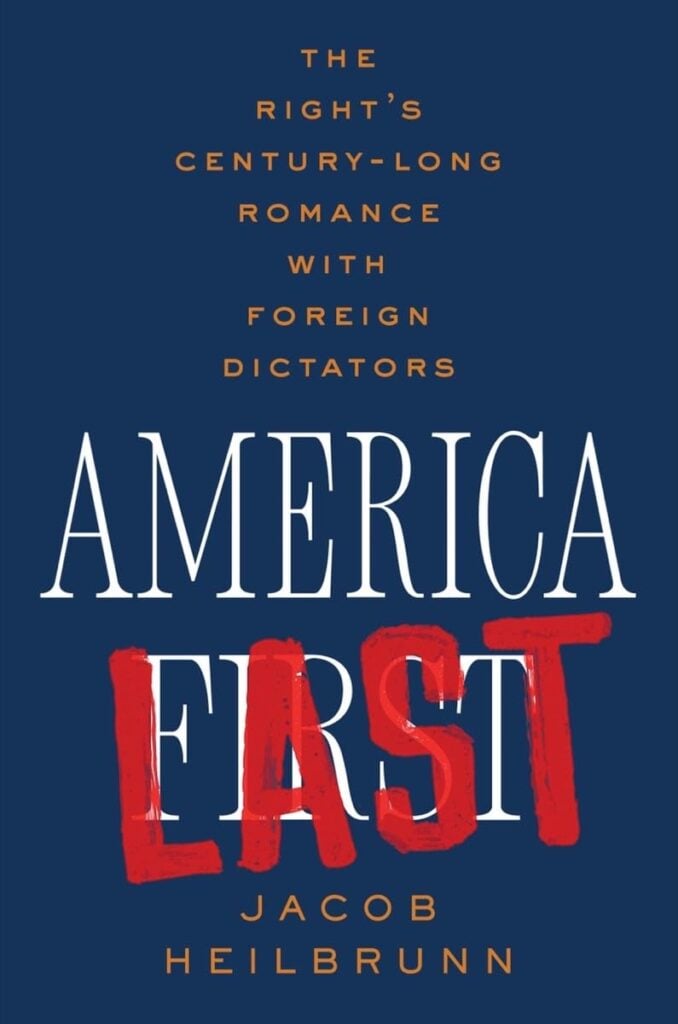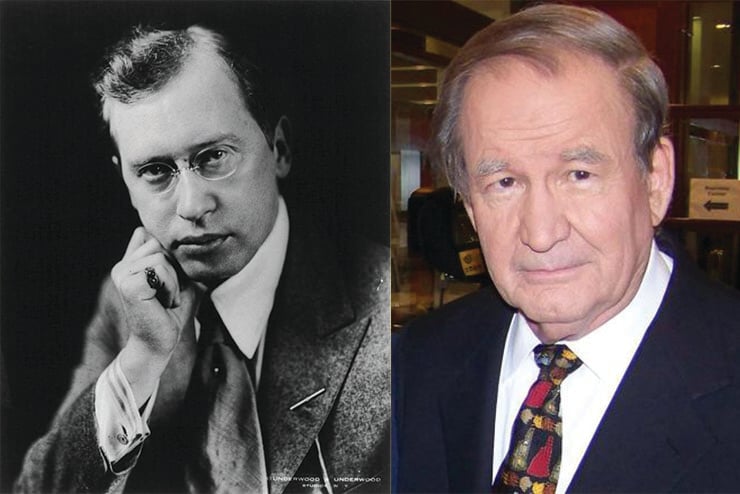
America Last: The Right’s Century-Long Romance with Foreign Dictators
by Jacob Heilbrunn
New York: Liveright, 2024
$28.99, 228 pp.
In America Last, the editor of The National Interest, Jacob Heilbrunn, accuses the Trumpian “New Right” of sundry pro-Hungarian and Russophile crimes, a “fascination for foreign autocrats,” and a disposition to intervene … nowhere! His book traces the coming of this evil “America First” disposition as far back as the dissenters to America’s involvement in World War I.
Like a dozen other books over the last several years that attempt to discredit the intellectual history of the right, including those by Rachel Maddow, John Ganz, Robert Kaplan, and Steven Hahn, Heilbrunn’s contribution is clearly an anti-Trump manifesto written to guide “the Resistance” and strengthen their wills. It may do that, but it hardly improves anyone’s understanding of American history, the political right, or the policy of military nonintervention.
Beginning in 1900, Heilbrunn writes, Prussia—the world’s most illiberal state—craved global supremacy. The “monstrous” Kaiser William II prefigured Hitler and the Kaiser’s American admirers H. L. Mencken and George Sylvester Viereck did endless harm by defending him.
Mencken was, to Heilbrunn, an anti-American Nietzschean who “coldly noted” that the Lusitania carried munitions (it did) and predicted the persecution of German Americans (accurately, it turns out). Further, Mencken had the worst traits of a would-be aristocrat: He was racist, anti-Semitic, elitist, and sexist. Despite his supercilious attitude, Mencken adopted a posture of victimhood that soon characterized the entire prewar “Old Right,” according to Heilbrunn.
As a paid German agent and tireless propagandist, Viereck sinned gravely in advocating for America stay out of both world wars.
Heilbrunn says that after America’s big overseas adventure in World War I, Old Right historical “revisionists” stalked the land speaking unkindly of Woodrow Wilson, as well as the bankers and arms manufacturers who helped push the United States into the war. Progressives Harry Elmer Barnes and Charles Beard joined in.
“Small-town” intellectual and former Anglican clergyman Albert Jay Nock venerated the Germans, Heilbrunn writes, and later mentored National Review Editor William F. Buckley, Jr. Nock joined the revisionist fray with his book The Myth of a Guilty Nation (1922) and founded the libertarian magazine The Freeman.
In the 1920s, the phrase “America First” was everywhere. William Randolph Hearst used it. So did President Harding. Heilbrunn attempts to tie this bare phrase to the anti-immigration movement, racism, the KKK, and a host of other evils, including the eugenics fad that was at that time shared across the political spectrum. This naturally brings him to racial theorist Lothrop Stoddard, whose New England pedigree Heilbrunn cheerfully admits before describing a whole northeastern WASP network promoting the Nordic racism theories of naturalist Madison Grant.
At this point in the book, Heilbrunn makes a sharp transition to Americans who admired Benito Mussolini (“In their hearts, they knew he was right,” he writes, cleverly ripping off a 1964 Goldwater campaign slogan). American Legion leader Alvin Owsley admired the operatic Italian strongman. So too, did the New Humanist thinkers, including Paul Elmer Moore, Irving Babbitt, and T. S. Eliot—all of them, in Heilbrunn’s view, fascistic upper-class twits. Babbitt thought we might someday need a Mussolini to thwart an American Lenin. The poet Ezra Pound fretted about usury and was later imprisoned for treason. New Englander Richard Washburn Child, U.S. ambassador to Italy, favored the black shirts. There was indeed a lot of authoritarian thinking across the political spectrum, but poor Heilbrunn ignores obvious connections to precedents set by Woodrow Wilson’s own rather totalitarian wartime practices.
The American right, Heilbrunn says, then looked to fascist Italy, Germany, Spain, and Oswald Mosley in Great Britain. As Mencken allegedly toyed with fascist doctrine, Lawrence Dennis, the “brains” of U.S. fascism, took the palm. A black man passing for white, he rose through elite American institutions: Philips Exeter, Harvard, and the Foreign Service. Critical of U.S. economic imperialism, he cared little for “liberal democracy” and was soon “functioning as a Nazi agent.”
The Spanish Civil War, the author says, was a dress rehearsal for World War II. While wicked men held FDR to the U.S. Neutrality Acts, the brave volunteers of the Abraham Lincoln Brigade went to fight for Stalin. Quite shockingly to Heilbrunn, American Catholics supported Franco, as did Fr. Charles Coughlin.
By 1940, the Roosevelt administration was attacking the domestic “fascists” and “appeasers.” Guarding his flank, Heilbrunn allows that “some historians” have seen this as a Brown Scare. Adducing Charles Lindbergh, eagle crosses, and Nordic racism, Heilbrunn still writes that “more than a few” isolationists were pro-fascist. Even worse, their Francoism, anti-Semitism, and Anglophobia survived World War II.
Revisionism, too, rose again with John T. Flynn’s The Truth About Pearl Harbor (1944), which argued FDR intentionally provoked the Japanese into attacking to provide a casus belli. The new revisionists questioned the morality of saturation bombing, the wisdom of the unconditional surrender policy, and the agreements between the U.S., Britain, and the USSR at Tehran and Yalta. They did all this, according to Heilbrunn, in aid of “rehabilitating a genocidal regime.”
The ungrateful American right also redbaited the heroic anti-communist Harry Truman, Heilbrunn complains. Led by Senator Robert Taft, the Old Right wanted unilateral “selective intervention” on behalf of Chiang Kai-shek, the new Franco. Citing the libertarian noninterventionist Murray Rothbard, Heilbrunn tries to argue that the right had been inconsistent in its nonintervention policy.
When Joe McCarthy, a Midwestern Catholic, made war on Eastern Establishment WASPs, Buckley championed him. Buckley’s father, a Texas oilman, hated the Mexican Revolution, and Junior was an authoritarian anti-Semite like his dad, Heilbrunn explains. As an adolescent, Buckley was active in the America First Committee and read Nock. He was also influenced by the political philosopher Willmoore Kendall, who brought Buckley into the CIA. Kendall hated liberal intelligence officers, foreshadowing, Heilbrunn says, the current attacks on the deep state.
Buckley’s National Review disliked decolonization, opposed desegregation, defended South Africa, and continued the right’s old habit of finding new foreign strongmen to lionize, such as Moise Tshombe of the Congolese province of Katanga, Jonas Savimbi in Angola, and Augusto Pinochet in Chile. Heilbrunn contrasts Savimbi’s wickedness with Nelson Mandela’s loving kindness (leaving aside Mandela’s history of violent terrorism).
But then the Soviets fell. Absent the Cold War, “the Old Right began to stir … against liberal hawks and neo-conservatives,” Heilbrunn writes. Patrick Buchanan opposed the First Gulf War, raising once more the cry of “America First.” But this feud with neocons really stemmed from 1982 when the scholarly critic of Abraham Lincoln, M. E. Bradford, whom Heilbrunn childishly insults as “troglodytic,” was blocked from heading the National Endowment for the Humanities.
Buchanan himself, a Catholic Anglophobe, was critical of Lincoln and an admirer of the Confederacy. Buchanan denounced official American free trade and its effect on the working class—the “white” working class, Heilbrunn interjects. Buchanan’s speech at the 1992 GOP convention launched a cultural crusade. Somewhere in these years, Heilbrunn says, Buchanan also began expressing sympathy for Russia. Taki Theodoracopulos, Scott McConnell, and Buchanan established The American Conservative to oppose the Second Gulf War. Contemplating the fact that the magazine is still around today, Heilbrunn wonders, “How did the Old Right reemerge triumphant?”
Heilbrunn then segues into a reprise of Russia Gate. Donald Trump’s pro-Russianism reflects “a long-standing tradition” that connects the Old Right with the New Right. The New Right loves Putin and actually defends him. And so, Heilbrunn declares, he’s proven the right’s longstanding “self-abasement before foreign tyrants,” which puts “America last.”
Alas, Heilbrunn’s approach reaches its limits early. He tries to stuff all his enemies in the same basket and deludes himself that he possesses the ability to read their minds. He treats World War I as a sort of nonevent that the Kaiser caused all by himself, but which the good guys won. Thus, it follows that opposition to another such military crusade can only arise from stupidity or malevolence. He seems unwilling to imagine that loyal Americans might have had a reason for avoiding a second such exercise in the 1930s.
Just as problematic is the author’s notion of a coherent “Right” that has remained substantially the same for a century. His attempt to seamlessly connect the prewar Old Right from Mencken and Nock through Buckley to Buchanan strains credulity. Even less convincing is his claim that this continuous right is uniquely disposed to admire foreign despots. Surely the many American leftist friends of Lenin, Stalin, and Mao can share in the glory.
In the end, a supposed intellectual who dismisses Mencken as a dyspeptic Germanophile, Nock as a smug elitist, and M. E. Bradford as a “vindictive” and “troglodytic” nobody, does not deserve serious attention. Whether he likes them or not, Heilbrunn shows little sign of grasping these important writers of American literary history, or the greater clash of ideas.

Leave a Reply